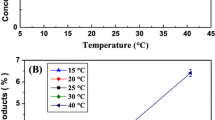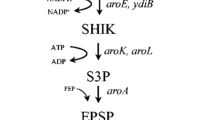Abstract
Objective
To solve the bottleneck of plasmid instability during microbial fermentation of l-DOPA with recombinant Escherichia coli expressing heterologous tyrosine phenol lyase.
Results
The tyrosine phenol lyase from Fusobacterium nucleatum was constitutively expressed in E. coli and a fed-batch fermentation process with temperature down-shift cultivation was performed. Efficient strategies including replacing the original ampicillin resistance gene, as well as inserting cer site that is active for resolving plasmid multimers were applied. As a result, the plasmid stability was increased. The co-use of cer site on plasmid and kanamycin in culture medium resulted in proportion of plasmid containing cells maintained at 100% after fermentation for 35 h. The specific activity of tyrosine phenol lyase reached 1493 U/g dcw, while the volumetric activity increased from 2943 to 14,408 U/L for l-DOPA biosynthesis.
Conclusions
The established strategies for plasmid stability is not only promoted the applicability of the recombinant cells for l-DOPA production, but also provides important guidance for industrial fermentation with improved microbial productivity.





Similar content being viewed by others
References
Akiyama H, Okuhata H, Onizuka T, Kanai S, Hirano M, Tanaka S, Sasaki K, Miyasaka H (2011) Antibiotics-free stable polyhydroxyalkanoate (PHA) production from carbon dioxide by recombinant cyanobacteria. Bioresour Technol 102(23):11039–11042
Balding C, Blaby I, Summers DA (2006) A mutational analysis of the ColE1-encoded cell cycle regulator Rcd confirms its role in plasmid stability. Plasmid 56(1):68–73
Baneyx F (1999) Recombinant protein expression in Escherichia coli. Curr Opin Biotechnol 10(5):411–421
Boe L, Gerdes K, Molin S (1987) Effects of genes exerting growth inhibition and plasmid stability on plasmid maintenance. J Bacteriol 169(10):4646–4650
Chandel M, Azmi W (2009) Optimization of process parameters for the production of tyrosine phenol lyase by Citrobacter freundii MTCC 2424. Bioresour Technol 100(5):1840–1846
Danino T, Prindle A, Kwong GA, Skalak M, Li H, Allen K, Hasty J, Bhatia SN (2015) Programmable probiotics for detection of cancer in urine. Sci Transl Med 7(289):289ra84
Dennig A, Busto E, Kroutil W, Faber K (2015) Biocatalytic one-pot synthesis of L-tyrosine derivatives from monosubstituted benzenes, pyruvate, and ammonia. ACS Catal 5:7503–7506
Fedorec AJ, Ozdemir T, Doshi A, Ho YK, Rosa L, Rutter J, Velazquez O, Pinheiro VB, Danino T, Barnes CP (2019) Two new plasmid post-segregational killing mechanisms for the implementation of synthetic gene networks in Escherichia coli. iScience 14:323–356
Frère JM (2010) Beta-lactamases and bacterial resistance to antibiotics. Mol Microbiol 16(3):385–395
Knowles WS (1986) Application of organometallic catalysis to the commercial production of L-DOPA. J Chem Educ 63(2):222–225
Koyanagi T, Katayama T, Suzuki H, Onishi A, Yokozeki K, Kumagai H (2009) Hyperproduction of 3,4-dihydroxypheny-L-alanine (L-Dopa) using Erwinia herbicola cells carrying a mutant transcriptional regulator TyrR. Biosci Biotechnol Biochem 73(5):1221–1223
Lee GE, Joshi BV, Chen W, Jeong LS, Moon HR, Jacobson KA, Kim YC (2008) Synthesis and structure–activity relationship studies of tyrosine-based antagonists at the human P2X7 receptor. Bioorg Med Chem Lett 18(2):571–575
Li T, Li X (2014) Comprehensive mass analysis for chemical processes, a case study on L-dopa manufacture. Green Chem 16:4241–4256
Liu T, Chen JY, Zheng Z, Wang TH, Chen GQ (2005) Construction of highly efficient E. coli expression systems containing low oxygen induced promoter and partition region. Appl Microbiol Biotechnol 68(3):346–354
Matsumoto T, Tanaka T, Kondo A (2017) Engineering metabolic pathways in Escherichia coli for constructing a “microbial chassis” for biochemical production. Bioresour Technol 245:1362–1368
McCubbin JA, Maddess ML, Lautens M (2006) Total synthesis of cryptophycin analogues via a scaffold approach. Org Lett 8(14):2993–2996
Milić D, Demidkina TV, Faleev NG, Phillips RS, Matkovićčalogović D, Antson AA (2011) Crystallographic snapshots of tyrosine phenol-lyase show that substrate strain plays a role in C–C bond cleavage. J Am Chem Soc 133(41):16468–16476
Millan AS, Maclean RC (2017) Fitness costs of plasmids: a limit to plasmid transmission. Microbiol Spectr 5(5):1–12
Min K, Park K, Park DH, Yoo YJ (2015) Overview on the biotechnological production of L-DOPA. Appl Microbiol Biotechnol 99(2):575–584
Nagatsua T, Sawadabm M (2009) L-dopa therapy for Parkinson’s disease: past, present, and future. Parkinsonism Relat Disord 15:S3–S8
Nguyen DP, Sladek RN, Do LH (2020) Scope and limitations of reductive amination catalyzed by half-sandwich iridium complexes under mild reaction conditions. Tetrahedron Lett 61(32):152196
Patient ME, Summers DK (1993) ColE1 multimer formation triggers inhibition of Escherichia coli cell division. Mol Microbiol 9(5):1089–1095
Pearce MC, Cabrita LD (2011) Production of recombinant serpins in E. coli. Methods Enzymol 501:13–28
Peubez I, Chaudet N, Mignon C, Hild G, Husson S, Courtois V, De Luca K, Speck D, Sodoyer R (2010) Antibiotic-free selection in E. coli: new considerations for optimal design and improved production. Microb Cell Fact 9:65
Phillips RS (2015) Chemistry and diversity of pyridoxal-5’-phosphate dependent enzymes. Biochim Biophys Acta 1854(9):1167–1174
Pursell MR, Mendes-Tatsis MA, Stuckey DC (2003) Coextraction during reactive extraction of phenylalanine using Aliquat 336: modeling extraction equilibrium. Biotechnol Bioeng 82(5):533–542
Rüdiger J, Schwab W (2019) Improving an Escherichia coli-based biocatalyst for terpenol glycosylation by variation of the expression system. J Ind Microbiol Biotechnol 46(8):1129–1138
Seisser B, Zinkl R, Gruber K, Kaufmann F, Hafner A, Kroutil W (2010) Cutting long syntheses short: access to non-natural tyrosine derivatives employing an engineered tyrosine phenol lyase. Adv Synth Catal 352:731–736
Semba H, Ichige E, Imanaka T, Atomi H, Aoyagi H (2010) Efficient production of active form recombinant cassava hydroxynitrile lyase using Escherichia coli in low-temperature culture. Methods Mol Biol 643:133–144
Sieben M, Steinhorn G, Müller C, Fuchs S, Ann Chin L, Regestein L, Büchs J (2016) Testing plasmid stability of Escherichia coli using the continuously operated shaken bioreactor system. Biotechnol Prog 32(6):1418–1425
Song YL, Peach ML, Roller PP, Qiu S, Wang S, Long YQ (2006) Discovery of a novel nonphosphorylated pentapeptide motif displaying high affinity for Grb2-SH2 domain by the utilization of 3’-substituted tyrosine derivatives. J Med Chem 49(5):1585–1596
Summers DK (1991) The kinetics of plasmid loss. Trends Biotechnol 9(8):273–278
Summers DK, Sherratt DJ (1984) Multimerization of high copy number plasmids causes instability: CoIE1 encodes a determinant essential for plasmid monomerization and stability. Cell 36(4):1097–1103
Summers DK, Sherratt DJ (1988) Resolution of ColE dimers requires a DNA sequence implicated in the three-dimensional organization of the cer site. EMBO J 7:851–858
Szpirer CY, Milinkovitch MC (2005) Separate-component-stabilization system for protein and DNA production without the use of antibiotics. Biotechniques 38(5):775–781
Tang XL, Liu X, Suo H, Wang ZC, Zheng RC, Zheng YG (2018) Process development for efficient biosynthesis of L-DOPA with recombinant Escherichia coli harboring tyrosine phenol lyase from Fusobacterium nucleatum. Bioprocess Biosyst Eng 41(9):1347–1354
Valdés RH, Puzer L, Gomes M Jr, Marques CESJ, Aranda DAG, Bastos ML, Gemal AL, Antunes OAC (2004) Production of L-DOPA under heterogeneous asymmetric catalysis. Catal Commun 5(10):631–634
Velur Selvamani RS, Friehs K, Flaschel E (2013) Extracellular recombinant protein production under continuous culture conditions with Escherichia coli using an alternative plasmid selection mechanism. Bioprocess Biosyst Eng 37(3):401–413
Velur Selvamani RS, Telaar M, Friehs K, Flaschel E (2014) Antibiotic-free segregational plasmid stabilization in Escherichia coli owing to the knockout of triosephosphate isomerase (tpiA). Microb Cell Fact 13:58
Yang C, Chen XD (2003) A class of simple models of time-dependent plasmid stability in a continuous fermentation process. Biochem Eng J 13:63–67
Zheng RC, Tang XL, Suo H, Feng LL, Liu X, Yang J, Zheng YG (2018) Biochemical characterization of a novel tyrosine phenol-lyase from Fusobacterium nucleatum for highly efficient biosynthesis of L-DOPA. Enzyme Microb Technol 112:88–93
Acknowledgements
This study was financially supported by the National Natural Science Foundation of China (No. 31900912)
Supporting information
Sequence of Cer site:
CCGGAAATACAGGAACGCACGCTGGATGGCCCTTCGCTGGGATGGTGAAACCATGAAAAATGGCAGCTTCAGTGGATTAAGTGGGGGTAATGTGGCCTGTACCCTCTGGTTGCATTTCATACGGTTAAAATTTATCAGGCGCGATCGCGGCAGTTTTTCGGGTGGTTTGTTGCCATTTTTACCTGTCTGCTGCCGTGATCGCGCTGAACGCGTTTTAGCGGTGCGTACAATTAAGGGATTATGGTAAATCCACTTACTGTCTGCCCTCGTAGCCATCGA.
Supplementary Table 1 Comparison of L-tyrosine derivatives production via chemical synthesis and biosynthesis.
Fig. S1 Recombinant plasmid construction map for Fn-TPL production by efficient fermentation with improved plasmid stability. (a) Plasmid map of pET-3a-KanR-Fn-TPL with original ampicillin resistance gene replaced by kanamycin resistance gene. (b) Plasmid map of pET-3a-KanR-cer1-Fn-TPL with cer site insertion in direction 1. (c) Plasmid map of pET-3a-KanR-cer1-Fn-TPL with cer site insertion in direction 2.
Fig. S2 Flow chart of plasmid stability test.
Fig. S3 Comparison of cell growth between recombinant E. coli harboring pET-3a plasmid and that without plasmid transformed.
Fig. S4 SDS-PAGE analysis for constitutive expression of Fn-TPL in recombinant E. coli. M: protein standard marker; Lane 1: Total protein of recombinant E. coli harboring pET-3a-AmpR-Fn-TPL plasmid; Lane 2: Protein sample from supernatant of cell-free extract of recombinant E. coli harboring pET-3a-AmpR-Fn-TPL plasmid; Lane 3: Protein sample from precipitate of broken cells of recombinant E. coli harboring pET-3a-AmpR-Fn-TPL plasmid.
Author information
Authors and Affiliations
Corresponding author
Ethics declarations
Conflict of interest
The authors declare that they have no competing interests.
Additional information
Publisher's Note
Springer Nature remains neutral with regard to jurisdictional claims in published maps and institutional affiliations.
Supplementary Information
Below is the link to the electronic supplementary material.
Rights and permissions
About this article
Cite this article
Tang, XL., Hu, WY., Wang, ZC. et al. Efficient strategies to enhance plasmid stability for fermentation of recombinant Escherichia coli harboring tyrosine phenol lyase. Biotechnol Lett 43, 1265–1276 (2021). https://doi.org/10.1007/s10529-021-03082-5
Received:
Accepted:
Published:
Issue Date:
DOI: https://doi.org/10.1007/s10529-021-03082-5




